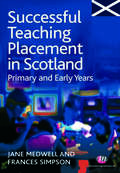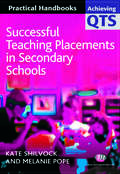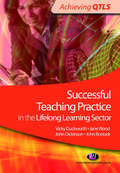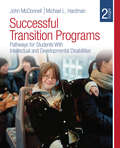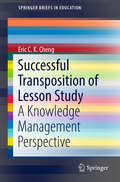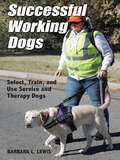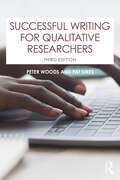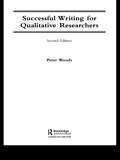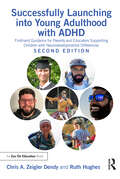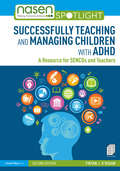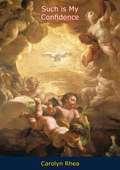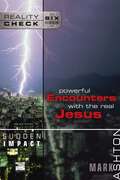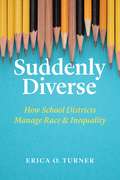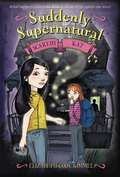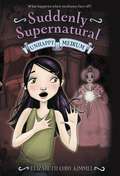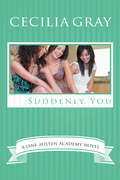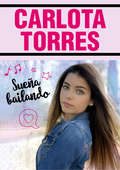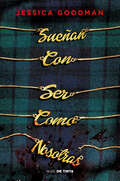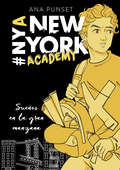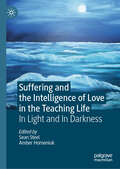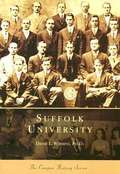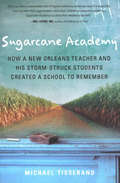- Table View
- List View
Successful Teaching 14-19: Theory, Practice and Reflection
by Dr Gerry Czerniawski Warren KiddAre you looking for a complete training manual, to get you through your assignments, help you on your teaching practice and support you in your first teaching job? For trainee teachers studying to teach the 14 to 19 age group in secondary schools and colleges, this book is a practical guide covering the essential skills that must be acquired in order to successfully complete your course. Five sections cover education policy, professional skills, theory, practice and reflection. The authors provide teaching ideas that work, and that will help trainee teachers to improve their grades and lesson observation profiles. There is a clear explanation of the theoretical underpinning that must be grasped in order to pass written assignments, and Masters level debates are addressed throughout the book, with a dedicated chapter exploring academic themes and issues. The book is packed with ideas for classroom activities, and popular topics covered include: - essential educational theory - behaviour and classroom management - how to start off lessons - ideas for group work - setting homework - evaluating your own practice, and understanding how you can improve - revising for exams - working as part of a team - using technology All the chapters contain learning objectives, discussion points, examples from practice, Masters level extensions (for those studying at that level) and suggestions for further reading. Suitable for all those studying to teach the 14 to 19 age range, this book is ideal for those on Secondary PGCE, PGDE and GTP courses leading to QTS, those studying for the post-compulsory sector PTLLS, DTLLS and CTLLS qualifications and those doing Overseas Teacher Training and Teach First courses. Warren Kidd and Gerry Czerniawski are former teachers with experience of working in diverse settings; they are both Senior Lecturers in the Cass School of Education, University of East London. Read Warren Kidd's blog: here
Successful Teaching Placement Primary and Early Years
by Mary Briggs Jane Medwell Julie Neale Nigel Palmer George RaperSchool placements can be anxious and uncertain experiences for trainee teachers, and even for those with previous classroom experience a new school environment can be intimidating. This book is full of invaluable advice and practical suggestions that will help trainees prepare for, enjoy and make the most of this experience. It deals with the full range of issues, from finding out about the placement school to managing difficult behaviour on placement. This second edition is linked to the 2007 Standards for QTS and reflects recent documents and initiatives.
Successful Teaching Placement in Scotland Primary and Early Years (Books for Scotland Series)
by Frances Simpson Jane A MedwellThe majority of ITE students in Scotland are postgraduates with only one year to grasp the vast skills and knowledge required to become a primary teacher. Therefore, for many, school placement is a source of stress and worry. This book combines the information and support that students need to help them prepare for, enjoy and maximise the benefits of teaching placements for their professional development. It has been specifically written for the education system in Scotland, taking full account of the differences in practice and terminology that make English books of little use to trainees in Scotland.
Successful Teaching Placements in Secondary Schools (Achieving QTS Practical Handbooks Series)
by Kate Shilvock and Melanie PopeProfessional teaching placements are an essential part of secondary teacher training, with trainees spending around two thirds of their time in schools. This practical handbook helps trainees fully prepare for their school experience, offering the guidance and reassurance to ensure they are confident and successful during placement. It is full of invaluable advice and practical suggestions, with clear links to the Professional Standards for QTS throughout.
Successful Teaching Practice in the Lifelong Learning Sector (Achieving QTLS Series)
by John Dickinson Vicky Duckworth Jane Wood John BostockThis book provides clear guidance on how to approach initial teaching experience, how to plan effective sessions, how to work well with your mentor and how to make the most out of your new career. Through focusing on the real-life experiences of both in-service and pre-service trainee teachers, it offers the opportunity to reflect on and learn from an array of diverse teaching practice experiences from a wide range of vocational areas including construction, hair and beauty, Early Years, psychology, performing arts, law, English, Skills for Life and engineering.
Successful Transition Programs: Pathways for Students With Intellectual and Developmental Disabilities (Second Edition)
by Michael L Hardman John McDonnellAddressing the full range of curricular and instructional issues that face professionals working in middle school, high school, and post-high school programs, Successful Transition Programs: Pathways for Students With Intellectual and Developmental Disabilities, Second Edition is the most relevant text available for teachers and administrators. Authors John McDonnell and Michael L. Hardman take the position that the most effective transition programs are those that cumulatively build on the capacity of students for employment, community living, and citizenship.
Successful Transposition of Lesson Study: A Knowledge Management Perspective (SpringerBriefs in Education)
by Eric C. ChengThis book analyses the organisation cultures that promote Japanese Lesson Study, identifies the soul of lesson study, which is missing in other cultures, and discusses the conditions for successfully transplanting the Lesson Study to other cultures. Adopting Nonaka and Tateuchi’s (1995) SECI knowledge creation model as the analytical lens, it explores the tacit and explicit knowledge convention and creation processes in lesson study. Unpacking the mechanism of the knowledge management process and practices could assist policy makers and school administrators, educators in contextualising lesson study to their school systems. The book provides an accessible discussion of the benefits and challenges of introducing lesson study, and presents three new research dimensions to analyse it: reviewing the historical development of lesson study in terms of the pendulum swings between professional accountability and state accountability in developing the school-based curriculum and the national curriculum; examining lesson study as a knowledge management tool for creating pedagogical knowledge for curriculum implementation: and studying the “kaizen kata” embedded in the PDCA cycles of lesson study as an organization routine for school improvement.
Successful Working Dogs: Barbara L. Lewis Select, Train, And Use Service And Therapy Dogs
by Barbara LewisThe last twenty years have seen an explosion of uses for working dogs. Service dogs are now asked to perform a variety of tasks for people with disabilities. And therapy dogs—once largely seen only at nursing homes—are now used for emotional support and motivation in schools, libraries, courts, universities, hospitals, churches and employee lounges. This book provides positive-motivation training techniques for basic manners and specific tasks expected of working dogs. Beyond training these animals, the reader can learn to evaluate both the suitability of a working dog and the suitability of the dog’s client. A final goal of this book is to help working dog owners, clients, and trainers—and dog owners in general—to understand the capabilities, needs and limitations of these dedicated animals.
Successful Writing for Qualitative Researchers (Routledge Study Guides)
by Pat Sikes Peter WoodsThe fully updated third edition of Successful Writing for Qualitative Researchers includes new material on the nature of qualitative research and the significance of contemporary circumstances in which academic writers have to work, as well as ethical considerations and authorial responsibilities. It provides a wealth of information and practical tips required to successfully translate qualitative research into writing. Using a wide range of examples, the authors provide tried and tested methods that explore the mindsets, strategies and techniques involved in successful qualitative writing, and the opportunities and rewards that are available. Considering the continuing pressure on researchers to produce high-quality writing in difficult circumstances, this book contains a wealth of information and provides guidance on: The nature of qualitative research The conditions for successful writing The responsibilities of the author Getting started and keeping going Organising your work Traditional and arts-based modes of writing Styles of writing Editing your work Preparing for publication Clear, concise, and engaging, this must-read guide is suitable for all those in the social sciences seeking to formulate their qualitative research into writing with maximum effectiveness, including undergraduates, postgraduates, and academics, whether in dissertations, theses, research reports, journal and magazine articles, conference papers or books.
Successful Writing for Qualitative Researchers (Routledge Study Guides)
by Peter WoodsIt is always difficult to know how to write up research, and as academics and postgraduates alike come under increasing pressure to improve rates of publication a text like this one is essential reading for all researchers. The book discusses all aspects of translating research into writing, including: * getting started and keeping going* putting into words what you want to say* ways of organizing your work* coping with problems, blockages and sustaining morale*style and format*editing your writing*writing alone and writing in a team*approaching problems and getting published. This book will be of use to students, researchers and writers concerned with getting their research written and having it published.
Successfully Launching into Young Adulthood with ADHD: Firsthand Guidance for Parents and Educators Supporting Children with Neurodevelopmental Differences
by Chris A. Zeigler Dendy Ruth HughesThis new edition of Successfully Launching into Young Adulthood with ADHD provides firsthand guidance for both parents and professionals to help teens prepare for a bright future after high school. The advice and strategies outlined in this book are evidence based and provide much-needed guidance to parents and the professionals who educate, coach and treat these students. This guidance will ensure that teens are ready to meet upcoming challenges and demands after high school graduation. With an always hopeful and personable message, the authors share their own and other parents’ insights on avoiding common missteps, the perils of a premature launch to college and finding what works for their unique child. Updated chapters include a discussion around medications and new information on gap year programs, and college accommodations. This top-notch guide is essential reading for any parent raising a young adult with ADHD and for the professionals who work with them.
Successfully Teaching and Managing Children with ADHD: A Resource for SENCOs and Teachers (nasen spotlight)
by Fintan J O'ReganWritten by one of the UK's leading experts in ADHD, O’Regan’s Successfully Teaching and Managing Children with ADHD is an invaluable resource offering practical and effective strategies for managing the difficult and often disruptive symptoms of ADHD in the classroom setting. Alongside the accessible and user-friendly resources that have made the first edition so valued, this second edition offers: A greater number of case studies addressing the key issues surrounding ADHD in education Up-to-date information and advice regarding medication and behavioural strategies Specific advice on recognising and managing ADHD in girls and adults Chapters in this book explore topics such as recognising and managing ADHD behaviour; working with parents of children with ADHD; whole school approaches to ADHD; and professional development for teachers and assistants. With accompanying assessment and management resources including the CAST (Child ADHD Screening Tool), this is an essential tool for teachers, SENCOs, behavioural management staff and senior leaders.
Such is My Confidence
by Carolyn RheaFirst published in 1961, this great book provides the reader with spiritual guidance and inspiration, with the purpose of leading the reader toward happier lives.In Such is My Confidence, using pertinent biblical references as her guidelines, author Carolyn Rhea examines various subjects relating to one’s inner world, including as faith, hope, love, joy, sorrow, comfort, disappointment, patience, happiness, compassion, suffering, humility and courage. In the author’s own words, her purpose in sharing her simple convictions is that of “urging everyone to define more clearly his own beliefs.”A comforting book to turn to in today’s complex modern world.
Sudden Impact: Powerful Encounters with the Real Jesus (Reality Check)
by Mark AshtonThe Reality Check series makes just one assumption: that you’re serious enough about your spiritual journey to investigate Christianity with an open mind. This isn’t about joining anyone’s religious club—it’s about being real with yourself and with the others in your group. Since no one has all the answers, there’s plenty of room for discussion. After all, if there is any truth to the Bible’s stories about Jesus, then one thing he’d welcome are questions and opinions that come from honest, earnest hearts.Whatever your opinion is of Jesus, you can’t deny his impact. Men left their careers to follow him. Prostitutes and extortionists reformed their ways. Grief-stricken women regained lost loved ones. One religious leader sought his wisdom while others sought to kill him. Taking a compelling look at six very different encounters with Jesus and their impact on real, flesh-and-blood people, Sudden Impact helps you consider how you might respond if Jesus entered your own world and turned it upside down. Sudden Impact includes these sessions: The Professor The Roof Smashers The Corpse Soldiers and Criminals The Prostitute The Blue-Collar Man and the IRS AgentFor the Group LeaderReality Check is for spiritual seekers of every persuasion. Uncompromisingly Christian in its perspective, it steers wide of pat answers and aims at honesty. This innovative and thought-provoking series will challenge you and those in your group to connect heart to heart as together you explore the interface between Jesus, the Bible, and the realities of this world in which we live.
Suddenly Diverse: How School Districts Manage Race and Inequality
by Erica O. TurnerFor the past five years, American public schools have enrolled more students identified as Black, Latinx, American Indian, and Asian than white. At the same time, more than half of US school children now qualify for federally subsidized meals, a marker of poverty. The makeup of schools is rapidly changing, and many districts and school boards are at a loss as to how they can effectively and equitably handle these shifts.Suddenly Diverse is an ethnographic account of two school districts in the Midwest responding to rapidly changing demographics at their schools. It is based on observations and in-depth interviews with school board members and superintendents, as well as staff, community members, and other stakeholders in each district: one serving “Lakeside,” a predominately working class, conservative community and the other serving “Fairview,” a more affluent, liberal community. Erica O. Turner looks at district leaders’ adoption of business-inspired policy tools and the ultimate successes and failures of such responses. Turner’s findings demonstrate that, despite their intentions to promote “diversity” or eliminate “achievement gaps,” district leaders adopted policies and practices that ultimately perpetuated existing inequalities and advanced new forms of racism. While suggesting some ways forward, Suddenly Diverse shows that, without changes to these managerial policies and practices and larger transformations to the whole system, even district leaders’ best efforts will continue to undermine the promise of educational equity and the realization of more robust public schools.
Suddenly Supernatural: Scaredy Kat (Suddenly Supernatural #2)
by Elizabeth Cody KimmelFavorable Reviews for: Lily B. on the Brink of Cool"A pitch-perfect tween/teen vibe. Kimmel has it in spades."--Publishers Weekly"An entertaining novel that middle-school girls will pass to their friends."--Children's Literarture "A delightful heroine, sweeter than predecessors Georgia Nicholson and Adrian Mole-and hilarious."--Kirkus Favorable Reviews for: Lily B. on the Brink of Love"As witty and precocious as in the first book. . . . Lily's journal entries and advice columns, and her continued growth in learning to judge the character of would-be friends, deliver laughs and substance."--School Library Journal "This exuberant comedy of middle-school Love at First Sight will capture and delight its target audience. . . . Funny and full of great language. "--Children's Literature
Suddenly Supernatural: Unhappy Medium (Suddenly Supernatural #3)
by Elizabeth Cody KimmelIn this third Suddenly Supernatural book, spirit-seeing Kat has pretty much overcome her fear of communicating with ghosts. But when she and best friend Jac visit the Whispering Pines Mountain House and Kat is challenged to help a deceased medium make her way back into the light, things get a little darker. From battling off dark spirits to fighting with Jac, Kat's week-long stay at the haunted mountain house is anything but relaxing. The question is what will be scarier: facing off with a misguided spirit or with her best friend, whose mother happens to be their chaperone?
Suddenly You: The Jane Austen Academy (The Jane Austen Academy #4)
by Cecilia GrayFanny doesn't need friends or love at The Jane Austen Academy. She only needs her running and intends to lie low until she can try out for the Olympic track team. But the Academy is in danger, and in an effort to save it, Fanny must join forces with the friend she never knew she wanted. She finds herself center stage in the middle of the Academy's biggest love triangle as the lead in the school play... only this track star can't afford to break a leg.
Sueña bailando
by Carlota TorresEL PRIMER LIBRO DE CARLOTA TORRES. BAILE, AMISTAD, AMOR... ¡Y MUCHA MÚSICA! La vida de Carlota es la danza. Desde pequeña no ha dejado de luchar por su sueño y ahora, junto con su grupo, tiene la oportunidad de presentarse a la competición más increíble que jamás hubiera imaginado. Los duros entrenamientos, los nervios, su grupo de amigas y ese chico que no puede quitarse de la cabeza... ¿Por qué todo tiene que complicarse siempre en el peor momento?
Sueñan con ser como nosotras
by Jessica GoodmanUn thriller tenso y adictivo convertido en una serie de HBO. Todo en la vida de Jill y sus amigas es como de película. Carismáticas, intocables, destinadas a triunfar: sacan las mejores notas, organizan las fiestas más locas y todos en el instituto sueñan con ser como ellas. Y este va a ser el año de Jill, fijo. A no ser que el pasado se lo impida... Hace tres años, su mejor amiga Sheila fue asesinada por su novio, Graham. Él confesó, cerraron el caso y Jill intentó seguir con su vida. Pero, cuando empieza a recibir mensajes que defienden la inocencia de Graham, su año perfecto se viene abajo. Si él no mató Sheila, ¿quién lo hizo? Jill tiene que descubrir la verdad... aunque haya alguien dispuesto a todo para enterrar el pasado.
Sueños en la gran manzana (Serie New York Academy #Volumen 2)
by Ana Punset«Estoy cumpliendo mi sueño de vivir en Nueva York mientras estudio para ser escritora y Hugo me ha confesado que ¡quiere estar conmigo! Todo sería perfecto si no fuera porque tengo que ser sincera y contarle toda la verdad a Alma. No quiero más secretos, pero... ¿cómo puedo enfrentarme a la realidad sin perder nada por el camino?» #NewYorkAcademy Sofía está viviendo un momento maravilloso y no podría ser más feliz. Pero al regresar a Brooklyn tras pasar unos días en Valencia, tiene que bajar de las nubes y enfrentarse a algo que ha estado posponiendo: contarle a Alma, su mejor amiga, que ha empezado a salir con Hugo, el amor platónico de Alma. No es una conversación fácil y los secretos hacen que la situación en la residencia se vuelva de lo más tensa. Sofía tendrá que esforzarse al máximo para estar ahí para sus amigos mientras intenta sacar lo mejor desu poesía para ganar un concurso de escritura que organiza la academia.
Suffering and Hope: The Biblical Vision and the Human Predicament
by J. Christiaan BekerA scholarly exploration of the topic.
Suffering and the Intelligence of Love in the Teaching Life: In Light and In Darkness
by Sean Steel Amber HomeniukThis book shares insights drawn from the diverse voices of public school teachers, community outreach education workers, professors, writers, poets, artists, and musicians on suffering in school and the classroom. Teachers speak about their own encounters with and perceptions from suffering using critical-analytic textual works, as well as first-hand personally reflective accounts. By sharing their stories and reflections, the editors and contributors shed light upon the dark areas that often are not addressed in Teacher Training Programs, and that generally remain unaddressed and unacknowledged even as teachers become well-established as professionals in the field of education.
Suffolk University (The Campus History Series)
by David L. RobbinsSuffolk University grew from humble beginnings in the Roxbury parlor of Gleason L. Archer, a lawyer who had worked his way through high school and college. A chance meeting brought him together with a benefactor who loaned him money for his law school studies, asking only that Archer pass along the favor. By 1930, Archer had built Suffolk University into one of the largest law schools in the country. The College of Arts and Sciences was founded in 1934, and the Sawyer School of Management -- then known as the College of Business Administration -- was established in 1937. That same year, the three academic units were incorporated as Suffolk University. Suffolk University contains images that show the depths and breadth of this institution that has called Beacon Hill home for 100 years. Whether known as the Rams, the Ramblers, or the Royals, the Suffolk spirit shines through.
Sugarcane Academy: How a New Orleans Teacher and His Storm-Struck Students Created a School to Remember (Harvest Original Ser.)
by Michael TisserandThis inspiring story of a post-Katrina classroom &“reminds us all that heroes hold small hands on field trips, clean paint brushes, and sing morning songs&” (Phillip Done, author of 32 Third Graders and One Class Bunny: Life Lessons from Teaching). As floodwaters from Hurricane Katrina surged at their heels, those fleeing New Orleans had their minds more on safety than on whether their children would be missing school. But when a group of evacuee parents who settled in New Iberia, Louisiana, realized they would not be returning home quickly, they set about reconstructing their families&’ lives. And so they turned to beloved New Orleans schoolteacher Paul Reynaud, whose fierce determination and unwavering spirit transformed an abandoned office into a one-room schoolhouse. This is the story of Sugarcane Academy: twenty-five students, their devoted parents, an inspiring teacher, and the boundless power of learning. &“This wonderful memoir manages to do what a flood of news-reporting could not: see the tragedy of Katrina through the eyes of children. The story of the Sugarcane Academy, an improvised one-room school in a sugarcane parish in south Louisiana, will be one of the lasting books of our tragedy.&” —Andrei Codrescu, author of New Orleans, Mon Amour: Twenty Years of Writings from the City


